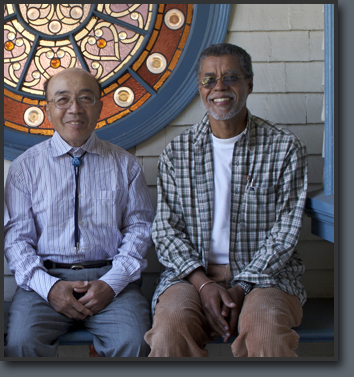
GENESIS![]()
On August 6, 2006, the anniversary of the U.S. bombing of Hiroshima, Jacques Depelchin, historian, author, and professor of Peace and Conflict studies at UC Berkeley, introduced photographer, Kathy Sloane to Keiji Tsuchiya and Michele Mason at a Peace Lantern Memorial in Berkeley, California. Tsuchiya, a Hiroshima survivor and long time Japanese nuclear abolition activist, was in the California Bay Area as a guest of Western States Legal Foundation, a non-profit peace and nuclear abolition advocacy group. Tsuchiya was scheduled for a number of public speaking engagements where he shared the story of his experiences in Hiroshima as a 17-year-old soldier during the month immediately following the dropping of the atomic bomb. Unique to his storytelling were 12 watercolors that Tsuchiya had made five years previously, which depicted his memories of those appalling days. He conceived of them as visual aides, which he found necessary to ensure that young people, two generations after the bombings, would understand the horror of nuclear war.
Depelchin suggested Sloane make photographs of the paintings, and tape Tsuchiya’s memories, and she readily agreed to do so the following day, just before Tsuchiya returned to Japan. Michele Mason, then a postdoctoral fellow in Japan Studies at Stanford University, and Tsuchiya’s host, invited Sloane and Depelchin to her home to make the photos and tape his story. She provided a fluid, nuanced consecutive translation of Mr.Tsuchiya’s story, which grew in the telling to include his lifelong commitment to preserving the life and habitat of the Japanese horseshoe crab. It was Mr. Tsuchiya’s response to Sloane’s question about the connection between his experiences in Hiroshima and his devotion to saving the crab that provoked Sloane into making a film out of her still photographs. The photographs and tape were made over a period of two hours. There was no time for re-reording or re-shooting.
 |
Keiji Tsuchiya, Jacques Depelchin |
Sloane had never made a film before and did the entire rough edit of sound and picture using her Apple laptop. The Fleishhacker Foundation gifted the film with a post production grant.
Jessie Spencer, a seasoned and highly respected video editor, joined Sloane transferred the work to professional editing equipment, and took Sloane’s film through to the final edit.
The film took two years to complete with the enormous support of composer Anthony Brown, sound mixer Dan Olmsted, and co-producer Michele Mason, who was a crucial part of this project from the start.
